
Visual art of the United States or American art is visual art made in the United States or by U.S. artists. Before colonization, there were many flourishing traditions of Native American art, and where the Spanish colonized Spanish Colonial architecture and the accompanying styles in other media were quickly in place. Early colonial art on the East Coast initially relied on artists from Europe, with John White the earliest example. In the late 18th and early 19th centuries, artists primarily painted portraits, and some landscapes in a style based mainly on English painting. Furniture-makers imitating English styles and similar craftsmen were also established in the major cities, but in the English colonies, locally made pottery remained resolutely utilitarian until the 19th century, with fancy products imported.

Gilbert Stuart was an American painter born in the Rhode Island Colony who is widely considered one of America's foremost portraitists. His best-known work is an unfinished portrait of George Washington, begun in 1796, which is usually referred to as the Athenaeum Portrait. Stuart retained the original and used it to paint scores of copies that were commissioned by patrons in America and abroad. The image of George Washington featured in the painting has appeared on the United States one-dollar bill for more than a century and on various postage stamps of the 19th century and early 20th century.

John Trumbull was an American artist of the early independence period, notable for his historical paintings of the American Revolutionary War, of which he was a veteran. He has been called the "Painter of the Revolution".

The National Portrait Gallery (NPG) is a historic art museum between 7th, 9th, F, and G Streets NW in Washington, D.C., United States. Founded in 1962 and opened in 1968, it is part of the Smithsonian Institution. Its collections focus on images of famous Americans. Along with the Smithsonian American Art Museum, the museum is housed in the historic Old Patent Office Building.
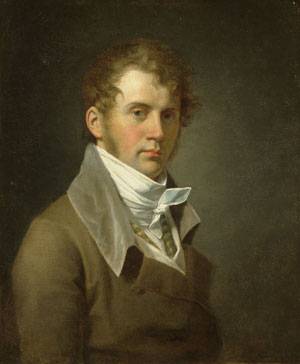
John Vanderlyn was an American neoclassicist painter.
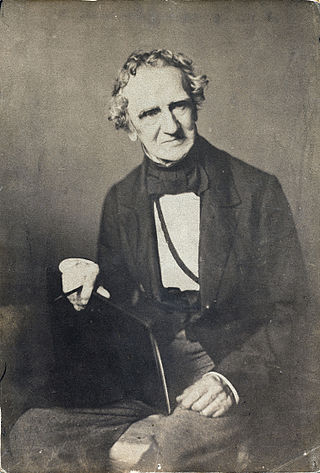
Thomas Sully was an American portrait painter in the United States. Born in Great Britain, he lived most of his life in Philadelphia, Pennsylvania. He painted in the style of Thomas Lawrence. His subjects included national political leaders such as United States presidents: Thomas Jefferson, John Quincy Adams, and Andrew Jackson, Revolutionary War hero General Marquis de Lafayette, and many leading musicians and composers. In addition to portraits of wealthy patrons, he painted landscapes and historical pieces such as the 1819 The Passage of the Delaware. His work was adapted for use on United States coinage.

The Boston Athenaeum is one of the oldest independent libraries in the United States. It is also one of a number of membership libraries, for which patrons pay a yearly subscription fee to use Athenaeum services. The institution was founded in 1807 by the Anthology Club of Boston, Massachusetts. It is located at 10½ Beacon Street on Beacon Hill.
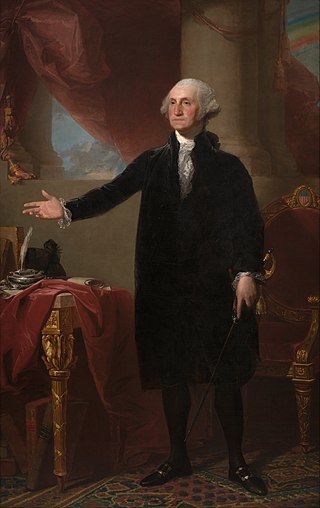
The Lansdowne portrait is an iconic life-size portrait of George Washington painted by Gilbert Stuart in 1796. It depicts the 64-year-old president of the United States during his final year in office. The portrait was a gift to former British Prime Minister William Petty, 1st Marquess of Lansdowne, and spent more than 170 years in England.

Stephen Arnold Douglas Volk was an American portrait and figure painter, muralist, and educator. He taught at the Cooper Union, the Art Students League of New York, and was one of the founders of the Minneapolis School of Fine Arts. He and his wife Marion established a summer artist colony in western Maine.
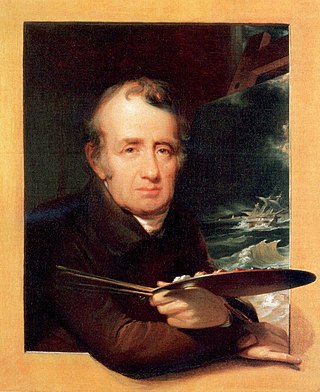
Thomas Birch was an English-born American portrait and marine painter.
Thomas Badger (1792–1868) was an artist in Boston, Massachusetts, in the 19th century. He specialized in portraits. He trained with John Ritto Penniman. Portrait subjects included: John Abbot; William Allen, of Bowdoin College; Asa Clapp; Julia Margaretta Dearborn; George B. Doane; Henry Wadsworth Longfellow; Benjamin Page; Thomas Paul, of Boston's African Meeting House; Jotham Sewall; Benjamin Vaughan; Charles Vaughan; Frances Western Apthorp Vaughan; George Wadsworth Wells; Jonathan Winship. Around 1849 a still life by Badger in the collection of the Boston Museum was considered "a highly finished and excellent picture, something in the style of Van Huysom. There is a truth and reality in the articles represented, seldom seen in this class of pictures."
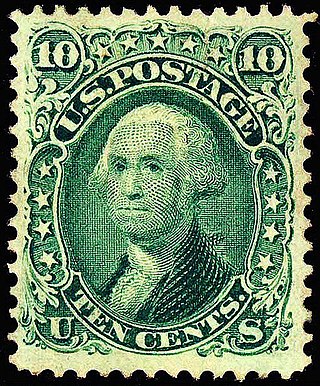
Presidents of the United States have frequently appeared on U.S. postage stamps since the mid-19th century. The United States Post Office Department released its first two postage stamps in 1847, featuring George Washington on one, and Benjamin Franklin on the other. The advent of presidents on postage stamps has been definitive to U.S. postage stamp design since the first issues were released and set the precedent that U.S. stamp designs would follow for many generations.

William James Hubard was British-born artist who worked in England and the United States in the 19th century. He specialized in silhouette and painted portraits.
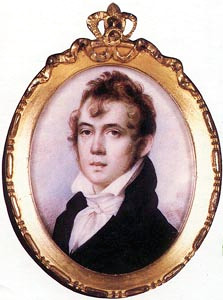
Anson Dickinson was an American painter of miniature portraits who achieved fame during his lifetime, producing a very large number of works, but who is now largely forgotten.
Jane Stuart was an American painter, best known for her miniature paintings and portraits, particularly those made of George Washington. She worked on and later copied portraits made by her father, Gilbert Stuart, and created her own portraits. In the early 19th century, she assumed the responsibility of supporting her family after her father's death. She first worked in Boston, but later moved to Newport, Rhode Island, where she was the first woman who painted portraits. In 2011, she was inducted into the Rhode Island Heritage Hall of Fame.
John Cranch was an American painter and print collector.
Nellie Mathes Horne was an American painter.
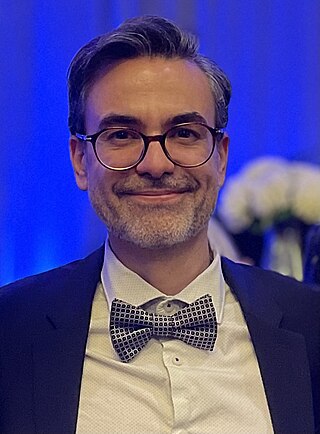
Luis Álvarez Roure is a Puerto Rican realist painter based in New Jersey. He is known for his figure paintings as well as his portraits of American public figures such as Philip Glass, Joshua Bell, Paul Volcker, Cándido Camero, Monsignor William Linder, and Octavio Vázquez. His strengths have been described as "his draftsmanship (...) taken directly from the paintings of past masters" and "the empathy he so evidently feels with his sitters" by Peter Trippi, editor-in-chief of Fine Art Connoisseur Magazine.

James Alexander Simpson was an American painter, best remembered today for his long association with Georgetown University.

The Portrait of George Washington Taking the Salute at Trenton is a large full-length oil on canvas painting by the Scottish artist John Faed depicting General George Washington on the battlefield at Trenton, New Jersey, during the American Revolutionary War. The equestrian portrait was the basis for the engraving Washington Receiving a Salute on the Field of Trenton by the British artist William Holl.



















